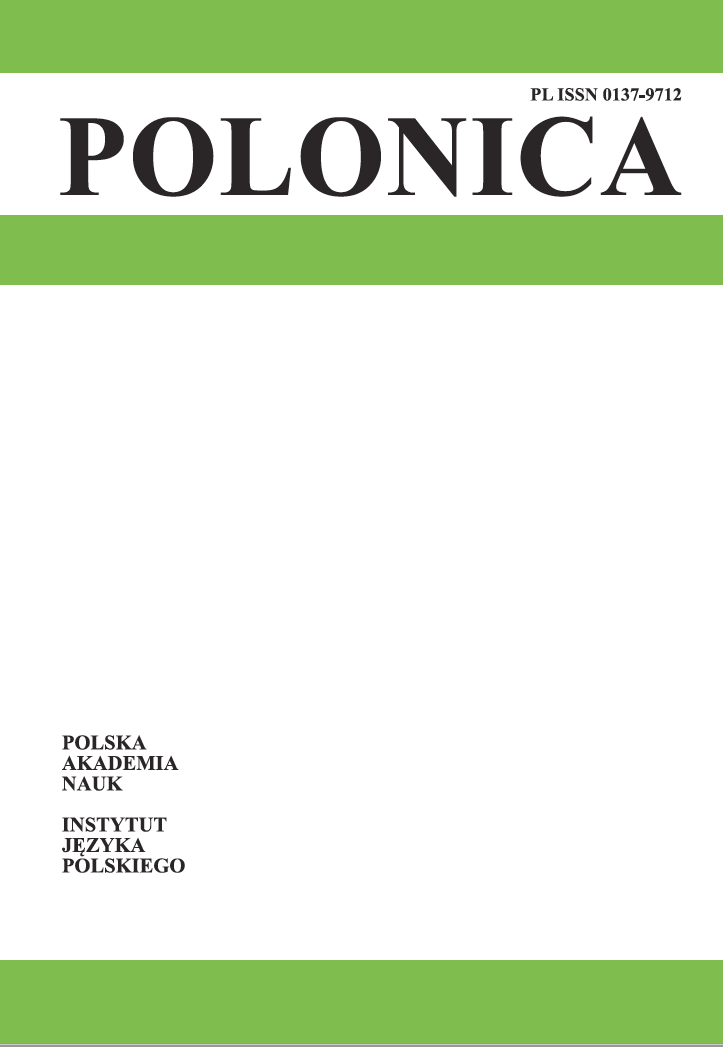Abstrakt
Artykuł ten dotyczy monotoniczności dwóch operatorów czasowych, mianowicie przed i aż do. Wszystkie operatory języka naturalnego mogą być albo monotonicznie rosnące, monotonicznie malejące albo niemonotoniczne. Pierwsze dwie z tych własności zazwyczaj oznaczają, że operator zachowuje albo odwraca kierunek wynikania. Jednak monotoniczność nie musi być definiowana za pomocą pojęcia wynikania. W artykule definiuję trzy rodzaje monotoniczności: ze względu na poprzedzanie w czasie, ze względu na relację bycia podzdarzeniem i ze względu na wynikanie. Te rodzaje monotoniczności pozwalają przedstawić różne definicje operatorów przed i aż do. Dzięki nim wysnute zostają przewidywania, które zostają następnie sprawdzone eksperymentalnie.
Bibliografia
Anscombe G.E.M., 1964, Before and after, The Philosophical Review, s. 3–24.
Barwise J., Cooper R., 1981, Generalized Quantifiers and Natural Language, Linguistics and philosophy 4 (2), s. 159–219.
Beaver D., Condoravdi C., 2003, A Uniform Analysis of “Before” and “After”, [w:] Proceedings of the 13th Semantics and Linguistic Theory Conference, s. 37–54.
Bott L., Noveck I.A., 2004, Some utterances are underinformative: The onset and time course of scalar inferences, Journal of memory and language 51 (3), s. 437–57.
Breheny R., Katsos N., Williams J., 2006, Are generalised scalar implicatures generated by default? An online investigation into the role of context in generating pragmatic inferences, Cognition 100 (3), s. 434–63.
De Neys W., Schaeken W., 2007, When people are more logical under cognitive load: Dual task impact on scalar implicature, Experimental psychology 54 (2), s. 128–33.
De Swart H., 1996, Meaning and use of not ... until, Journal of Semantics 13 (3), s. 221–63.
Geurts B., 1999, Presuppositions and Pronouns. Amsterdam–New York.
Grice H.P., 1989, Studies in the Way of Words, Harvard University Press.
Grodner D.J., Klein N.M., Carbary K.M., Tanenhaus M.K., 2010, „Some”, and possibly all, scalar inferences are not delayed: Evidence for immediate pragmatic enrichment, Cognition 116 (1), s. 42–55.
Hamm F., Bott O., 2014, Tense and Aspect, [w:] The Stanford Encyclopedia of Philosophy, red. E.N. Zalta, http://plato.stanford.edu/archives/spr2014/entries/ tense-aspect/, Stanford University.
Heinämäki O., 1972, Before, [w:] Papers from the 8th Regional Meeting of the Chicago Linguistic Society, Chicago Linguistic Society, Chicago, IL., s. 139–51.
Huang Y.T., Snedeker J., 2009, Online interpretation of scalar quantifiers: Insight into the semantics-pragmatics interface, Cognitive psychology 58 (3), s. 376–415.
Janowska A., 2015, Kształtowanie się klasy polskich przyimków wtórnych, Katowice.
Kamp J.A., 1968, Tense logic and the theory of linear order, praca doktorska, University of California, Los Angeles.
Kamp J.A., 1979, Events, instants and temporal reference, [w:] Semantics from di erent points of view, Berlin, s. 376–418.
Keenan E.L., Westerståhl D., 1997, Generalized quantifiers in linguistics and logic, [w:] Handbook of logic and language, London–Burlington, s. 837–893.
Landman F., 1991, Structures for Semantics, Dordrecht.
Laskowski R., 2003. Wyrażenia przyimkowe o funkcji temporalnej w języku polskim, [w:] Präpositione im Polnischen, red. G. Hentschel, Th. Mentzel, Studia Slavica Oldenburgensia 11, Oldenburg, s. 193–226.
Laskowski R., 2005, Temporalne frazy przyimkowe o funkcji prospektywnej i retrospektywnej, [w:] Przysłówki i przyimki. Studia ze składni i semantyki języka polskiego, red. M. Grochowski, Toruń, s. 209–225.
Nouwen R., 2008, Directionality in numeral quantifiers: the case of ‘up to’, Proceedings of the 18th Semantics and Linguistic Theory Conference, s. 569–582.
Noveck I.A., 2001, When children are more logical than adults: Experimental investigations of scalar implicature, Cognition 78 (2), s. 165–88.
Partee B., 2016, Formal semantics, [w:] The Cambridge handbook of formal semantics, red. M. Aloni, P.J.E. Dekker.
Przepiórkowski A., Bańko M., Górski R.L., Lewandowska-Tomaszczyk B., red., 2012, Narodowy Korpus Języka Polskiego, Warszawa.
Przybylska R., 2002, Polisemia przyimków polskich w świetle semantyki kognitywnej, Kraków.
Russell B., 1914, Our knowledge of the External World as a Field for Scientific Method in Philosophy.
Van Benthem J., 1984, Questions about Quantifiers, The Journal of Symbolic Logic 49 (02), s. 443–466.
Von Fintel K., 1999, NPI licensing, Strawson entailment, and context dependency, Journal of Semantics, 16 (2), s. 97–148.
Zacks J.M., Tversky B., 2001, Event structure in perception and conception, Psychological Bulletin, 127 (1), s. 3–21.
Zacks J.M., Tversky B., Iyer G., 2001, Perceiving, remembering, and communicating structure in events, Journal of Experimental Psychology: General 130 (1), s. 29–58.
Zwarts J., Winter Y., 2000, Vector space semantics: A model-theoretic analysis of locative prepositions, Journal of Logic, Language and Information 9 (2), s. 169–211.

